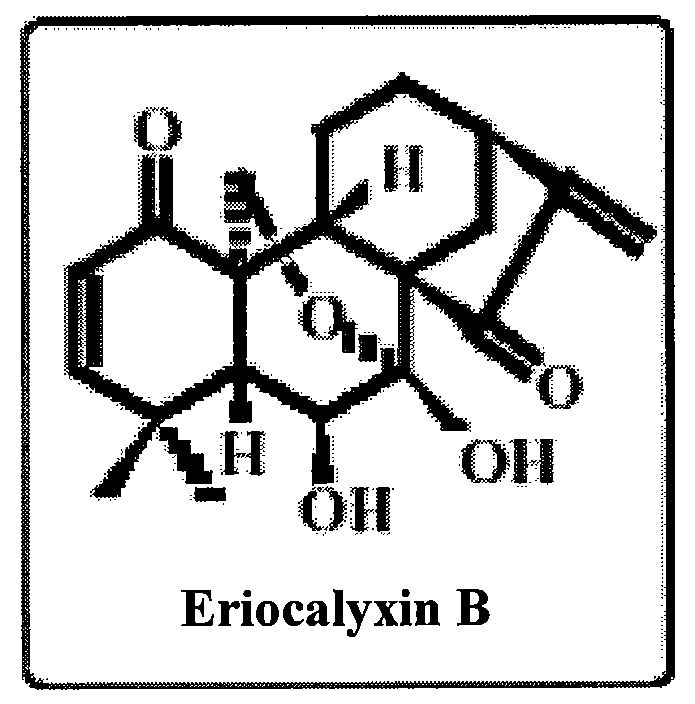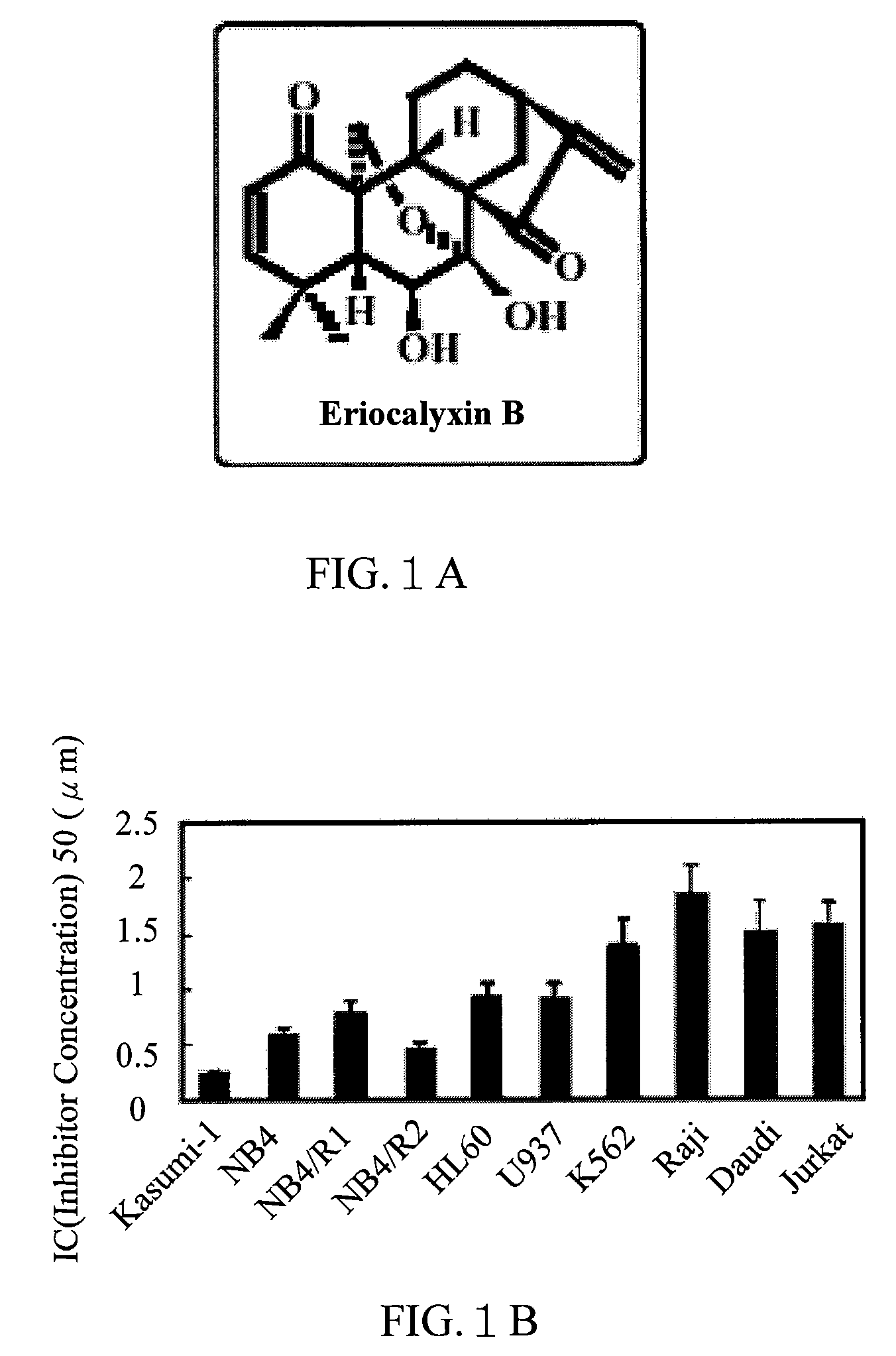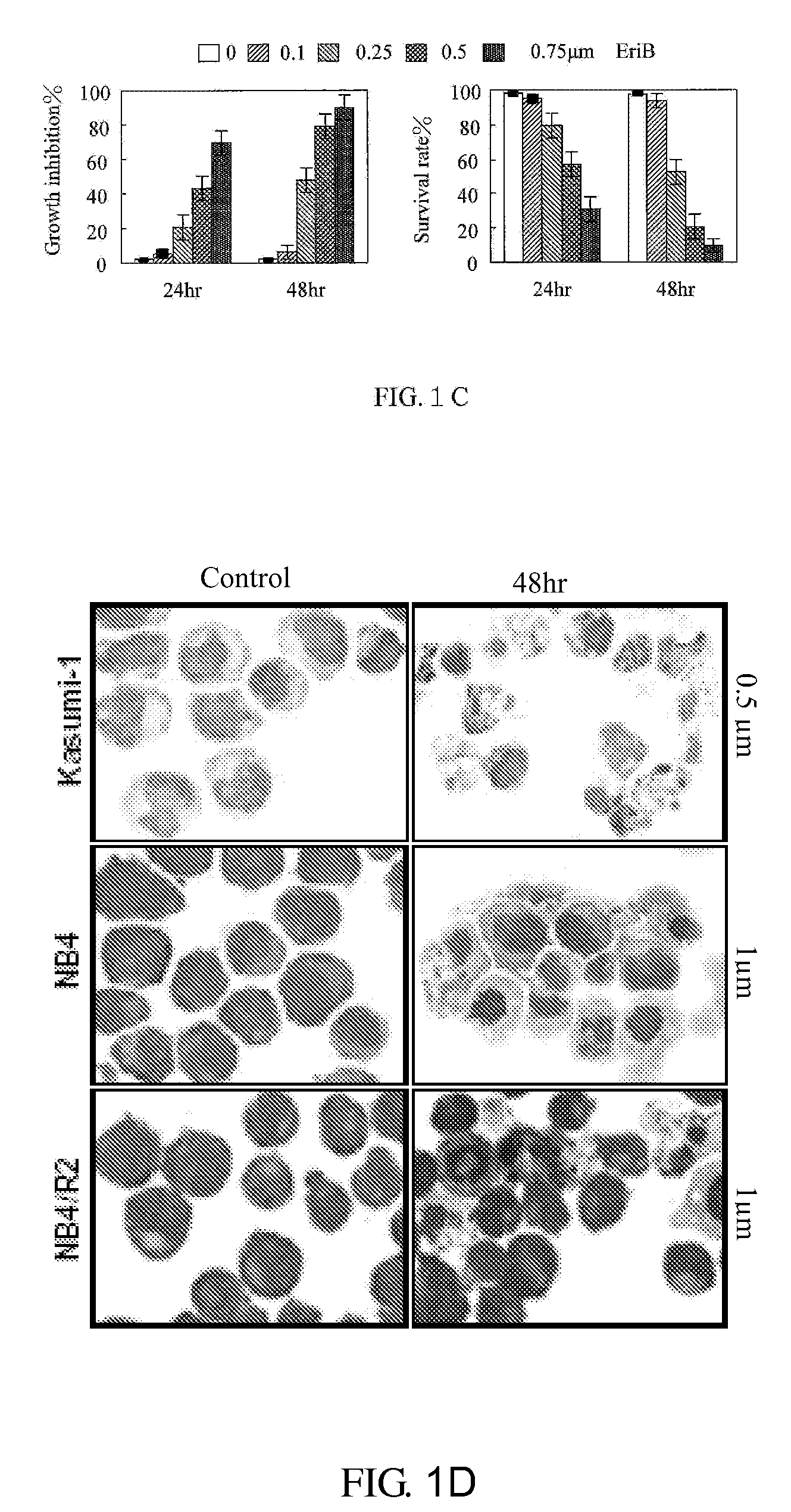Application of Eriocalyxin B in the Manufacture of Medicaments For Treating Leukemia
a technology of eriocalyxin and eriocalyxin b, which is applied in the direction of heterocyclic compound active ingredients, biocide, drug compositions, etc., can solve the problems of serious diseases such as malignant tumors, unsuitable for elderly patients with high doses of chemotherapy, and greatly endanger human lives and health, so as to reduce the threshold of erib-induced apoptosis and promote cell survival , the effect o
- Summary
- Abstract
- Description
- Claims
- Application Information
AI Technical Summary
Benefits of technology
Problems solved by technology
Method used
Image
Examples
embodiment 1
[0058]EriB can inhibit the growth of human leukemia cells and induce apoptosis. Using MTT method to detect the impact of EriB on human malignant hematopoietic cell growth shows that EriB inhibits the growth of these cells at between 0.2-2 μM, and different concentrations of EriB can also inhibit cell growth. EriB to Kasumi-1 cell growth inhibited half of the growth with inhibitor amount of 0.2 μM, to the NB4 and NB4 / R2 cells for amount of 0.5 μM, and to the NB4R1, HL60 and U937 cells for the amount of 1 μM. Lymphocyte proliferation of malignant diseases which are sensitive to EriB are lower than the myeloid leukemia cells, Raji, Daudi, and Jurkat cells and the IC50 values are higher than the 1.5 μM (see FIG. 1B).
[0059]As shown in FIG. 1C, Kasumi-1 cells are most sensitive to EriB, EriB to cell growth inhibition has time and dose dependencies (see FIG. 1C right), the survival rate also correspondingly decline (see FIG. 1C right). In less than 0.25 μM concentrations, can also observe ...
embodiment 2
[0062]Mitochondrial damage by EriB in induced apoptosis concentration, activated caspase-3. In order to study the Kasumi-1 cells in early ultrastructural changes of apoptosis and to find the mechanism involved in apoptosis, we had a transmission microscope analysis. The normal tumor cells nucleus are irregularly shape, containing a lot of rough endoplasmic reticulum and mitochondria (see FIG. 2B), Kasumi-1 cells treated with EriB for six hours later showed expansion of the cell, the increase in lysosome number, swelling and debilitated mitochondria (see FIG. 2B), which prompted the early cell apoptosis and mitochondrial damage (see FIG. 2B).
[0063]The Kasumi-1 cells treated with EriB and Rh123 (Rhodamine) after incubation are used for the flow cytometry detection, the results showed that mitochondrial transmembrane potentials decreased significantly, and have time and dose dependencies (see FIG. 2C). NB4 and NB4 / R2 cells in Kasumi-1 cells, caspase-3 cleaving also occurred simultaneou...
embodiment 3
[0064]EriB through downregulation of Bcl-2 and Bcl-XL to act on intrinsic apoptosis pathways. Bcl-2 family proteins directly control the mitochondrial membrane permeability, and they are caspase activation central regulators. The family of anti-apoptotic and pro-apoptotic members decided the fate of the cells whether to live or die. In order to detect whether EriB through the role of EriB in the Bcl-2 family members to act on mitochondrial damage, we used western blot and RT-PCR methods to detect the treatment of EriB for 24 and 48 hours later, Kasumi-1 cells situations in the anti-apoptotic factor Bcl-2 and Bcl-XL, and pro-apoptotic factor Bax expression. Bcl-2 and Bcl-XL in protein and mRNA levels have decreased, but the expressions of Bax have not changed significantly (see FIG. 3A and FIG. 3B). Ultimately, EriB induced Bcl-XL / Bax Bcl-2 / Bax ratio and the negative regulated (see FIG. 3C and FIG. 3D), and the results were consistent with Kasumi-1 apoptosis process of mitochondrial ...
PUM
| Property | Measurement | Unit |
|---|---|---|
| pH | aaaaa | aaaaa |
| temperature | aaaaa | aaaaa |
| pH | aaaaa | aaaaa |
Abstract
Description
Claims
Application Information
 Login to View More
Login to View More - R&D
- Intellectual Property
- Life Sciences
- Materials
- Tech Scout
- Unparalleled Data Quality
- Higher Quality Content
- 60% Fewer Hallucinations
Browse by: Latest US Patents, China's latest patents, Technical Efficacy Thesaurus, Application Domain, Technology Topic, Popular Technical Reports.
© 2025 PatSnap. All rights reserved.Legal|Privacy policy|Modern Slavery Act Transparency Statement|Sitemap|About US| Contact US: help@patsnap.com



